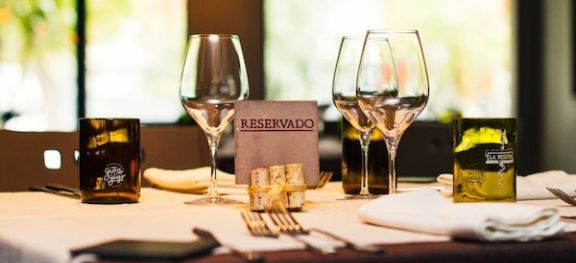The mystery of Chilean cuisine

Nick recalls a day in Santiago before the terrible recent rains in this article published by the Financial Times.
The scene was enchanting. Dappled sunlight streamed on to a terrace full of umbrella-shaded tables, each one laid up with cutlery and, a couple of hours later, with empty wine bottles. The menu was highly distinctive. The service had been attentive, particularly when the French chef appeared. And yet what we had just experienced was most unusual.
We had just finished lunch at La Misión, a restaurant in Santiago, Chile that started life out of its owners’ passion for wine, and this, our second excellent meal in the Chilean capital, only reinforced a question that had haunted me long before we had arrived here: why are there so few good examples of Chilean cuisine outside Chile?
Other than at Pomaire in mid Manhattan and a few Chilean restaurants in Melbourne, Australia, there is an absence of Chilean restaurants, and it remains a mystery. Particularly as many of the cooking styles, drinks and ingredients of southern America have been so readily embraced.
Wine and beef have together led to a huge rise in the number of Argentine and, to a lesser extent, Brazilian restaurants. And London has finally caught up with Mexico’s combination of tacos and margaritas that has been so popular in the US for years. The culinary talents of Gabriel Acuña and numerous other chefs in and around Lima have set in motion a style of Peruvian-inspired cooking that was unimaginable five years ago. So many young Peruvians are now heading into Chile that there are over 300 Peruvian restaurants in and around Santiago, I was reliably informed – far more than establishments expressly designed to showcase Chilean cuisine. All of which accentuates this lacuna.
Chile has obviously had the wine connection for many years. It has long had the same, and currently hugely popular, tradition of cooking meat over an open fire, and it possesses via its history many of the ingredients long neglected but slowly being recovered by young chefs. One way in which Chilean cuisine is distinctive is the fish and shellfish that is the produce of its long coastline (particularly attractive for sea urchin lovers such as myself) and that may be an inhibiting factor: neither the best nor the freshest fish and shellfish travel that far.
Part of the explanation, I now realise, lies in Chileans’ national identity. Intimidated for too long by Brazil and Argentina, and in dispute with Peru over the origins of pisco, Chileans have to date been somewhat backward at coming forward. All of these factors, sea urchins aside, left me less than enthusiastic about the prospect of eating out in Chile.
I therefore arrived quite unprepared for our first meal at Bocanáriz in the smart Lastaria district of the capital, which owners Katherine Hidalgo, 36, and her business partner Jerome Reynes, 56, opened in 2014 before opening La Misión in November 2016. Although in both the distinction between wine bar and a restaurant is blurred, the same love of wine is obvious, as is the wit on display.
Bocanáriz, which translates as nose and mouth, occupies a converted house, in which we sat in the former garage, with the owners’ enthusiasm for, and emphasis on, the wines of Chile immediately obvious. All the wines available by the bottle are written neatly on a large blackboard; there is a vast display of corkscrews framed on another wall; while the corkscrew shape is artfully adapted to signal each of the gents, ladies and disabled lavatories.

But while this may seem fairly commonplace, it is the next step taken by Bocanáriz‘s owners that really differentiates the wines they offer. Their speciality is wine flights, trios of different wines, whites and reds mixed by variety, geography or style. This is a particularly useful approach for the wines of a country so diverse and in such a constant state of flux.
The menu is as easy to navigate, broken down into 12 different categories that range from iodised (which included a particularly sharp salad of various seaweeds) to more mainstream Chilean dishes, which included particularly excellent beef empanadas seasoned with merkén, a long-established Mapuche chilli. More striking were two variations on eel, the first served as fried fillets on skewers with a dipping sauce and then in a chowder with potatoes, mussels and clams.
The decision to open La Misión cannot have been taken lightly. Located in a street full of smart shops but in a building where previously restaurateurs have not succeeded, it boasts two attractive assets other than tables on its sun-protected terrace.
Firstly, there is a wine list of 421 wines from throughout the Americas of which 41 are available by the glass, the fruits of a year’s research by its owners. Our main picture shows how they have cleverly adapted used corks into a stand for their Reservado notice.
Even more important is the bearded and pony-tailed French-born chef, Jonathan Michel. Having cooked in his native country and Japan, he has now turned his hand to Chile’s indigenous ingredients, particularly the shellfish. I was most impressed by a tangerine mayonnaise that accompanied very fresh locos, the large native mussel; a gazpacho that incorporated tiger’s milk (the base for all ceviche) and home-cured smoked salmon; and cappeletti filled with octopus and vegetables. A complicated dessert of a chocolate mille-feuille and anise pastry cream and a simpler one of strawberries in basil syrup with lemon ice cream provided a sweet finale.
But I still don’t understand why there are so few Chilean restaurants outside Chile. Perhaps it is because there are relatively few Chilean expats? Or perhaps it is because no one has yet invited Hidalgo and Reynes to open one?
Bocanáriz, Jose Victorino Lastarria, Santiago +56 22638 9893 www.bocanariz.cl
La Misión, Nueva Costanera 3969, Santiago +56 22208 8908 www.lamisionsantiago.cl
Become a member to view this article and thousands more!
- 15,399 featured articles
- 274,776 wine reviews
- Maps from The World Atlas of Wine, 8th edition (RRP £50)
- The Oxford Companion to Wine, 5th edition (RRP £50)
- Members’ forum
- 15,399 featured articles
- 274,776 wine reviews
- Maps from The World Atlas of Wine, 8th edition (RRP £50)
- The Oxford Companion to Wine, 5th edition (RRP £50)
- Members’ forum
- Commercial use of our Tasting Notes
